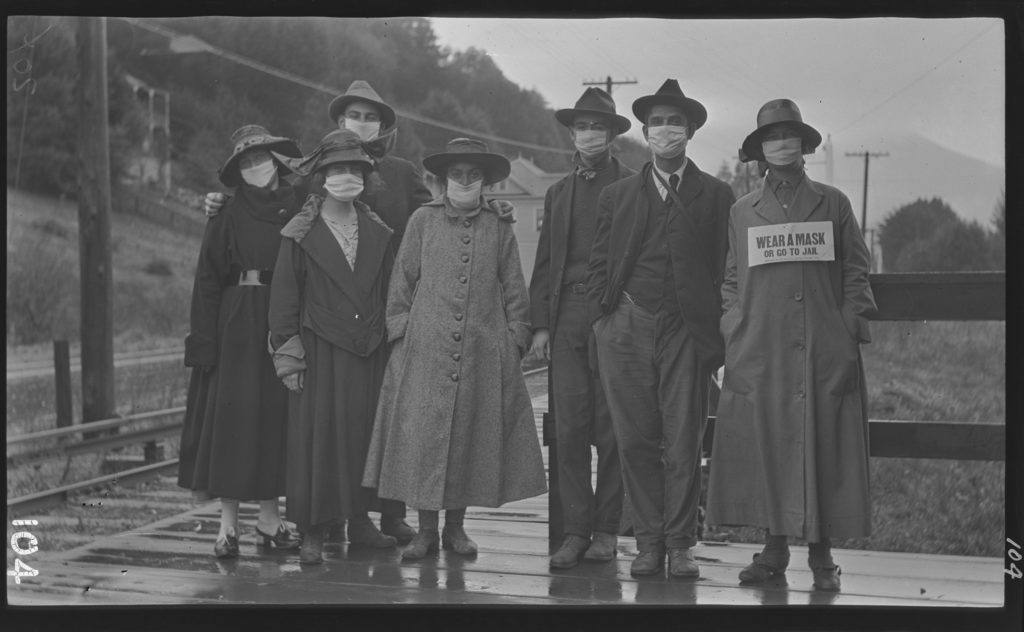Originally posted on the MN Annual Conference of the United Methodist Church on October 1, 2020
“The year just closing will ever remain memorable in the annuals of our church, as well as those of our beloved country.”
That’s what Litchfield District Superintendent William Chapell Lee wrote in his Annual Conference District Report in October 1919. He was reflecting on the impact of the 1918 Influenza Pandemic and the end of World War I, not only on the Methodist Church but on the entire nation. These same words ring true for us today as we live through COVID-19. As I’ve spent some time researching the impact that the 1918 pandemic had on Methodist churches in Minnesota, I’ve found that there are many similarities to our situation today.
Similar to today’s pandemic, the 1918 pandemic closed down much of society as officials struggled to slow the spread of illness. The first wave of influenza arrived in March 1918 when the United States and other countries reported a flu-like illness. By May, the Minneapolis Morning Tribune reported a mysterious illness was spreading throughout Spain and impacting 40 percent of the population. Over the subsequent months, influenza quickly spread throughout much of Europe and other parts of the world. By September, the second wave of influenza struck the United States as troops returned from Europe either ill or carrying the virus. It quickly made its way throughout the U.S. military bases and into the general public.
On Sept. 16, the Rochester Daily Post and Record reported that Minnesota had no cases. However, by Sept. 21, the same newspaper wrote about an individual who was ill with influenza. By Oct. 1, 266 cases were reported at Fort Snelling with at least 42 cases in the civilian population. Influenza continued to spread throughout Minnesota, and the Minnesota State Board of Health started to provide directives to local officials. For example, public funerals could occur but caskets had to remain closed. However, Rochester health officials placed additional restrictions and mandated that funerals must be private because the disease was so communicable. State officials also recommended that individuals avoid crowds, cover their coughs and sneezes, seek out fresh air, avoid sharing cups and community towels, and quarantine if they were sick.
For the most part, local officials determined when to close down their communities. By mid-October, many cities across the state had shut down schools, churches, theaters, dance halls, and pool halls, and prohibited public gatherings. On Oct. 25, all pastors affiliated with the Winona Ministerial Association agreed to close their churches to help prevent the spread of the disease. The impact of the closures was noted in the minutes of the Ladies Aid Society of the Methodist Episcopal Church in Redwood Falls, which noted they were on “vacation on account of the flu” during October and November.
Despite the closures, district supervisors noted in their 1919 Annual Conference Reports that ministry continued even with the restrictions in place.
The Mankato District wrote that “many of our homes…suffered severely from the flu.” The Marshall District reported that the quarantine regulations demobilized “Sunday School, Epworth Leagues, and church services” but did not stop the pastors who “counted not their lives dear, visited and frequently when trained nurses could not be secured, cared for the sick, buried the dead, and comforted the sorrowing.” The Winona District stated that “during the long siege of this disease, which desolated so many homes, our pastors gave themselves faithfully in ministering to the needs of both the souls and bodies of their parishioners.” In addition to the pandemic and war, the Duluth District faced a devastating fire in October that destroyed entire communities and five of its churches. Despite the challenges, the district reported that “relief was immediate and glorious” and “rebuilding was rapid” with “hundreds of people” volunteering their services.
When some churches were able to resume services in November and December, restrictions were placed on many. Minneapolis required that masks be worn, and churches could only allow every other row to be used and every other seat within in a row. Some communities left it to the discretion of ministers when they wanted to re-open. On Nov. 2, the Minneapolis Morning Tribune had an article stating “Methodists Announce General Resumption-Most Sunday Schools Closed.” The article noted that even if an individual’s church was not resuming services, other churches were available for them to attend.
Similar to today, not all ministers or parishioners agreed with the closures. On Dec. 26, the Rochester Daily Post and Record shared a letter written by Rev. J. Lawrence O’Connor to his Worthington congregation that questioned the necessity of closing churches. “The inability to hear Mass on Sunday generates a feeling of insistent sadness and gloom calculated rather to help than to counteract the spread of the epidemic,” he wrote. Still, it appears most churches followed the orders and directives from local officials.
Closures continued off and on into 1919 as communities responded to spikes in influenza cases. A third wave of the pandemic occurred in the winter and spring of 1919 and subsided by the summer. According to the Centers for Disease Control, by the time the pandemic ended, an estimated 500 million people or one-third of the world’s population had been impacted. It is estimated that 50 million people died, with 675,000 in the United States and over 10,000 in Minnesota.
Still, Minnesotans and Americans 100 years ago got through the influenza pandemic at a time when medical interventions and treatments were far less advanced than they are today. If nothing else, may this remind us that we can get through COVID-19 and that we will eventually come out on the other side with new tools, new ways of doing ministry, and a newfound appreciation for our ability to gather with our faith communities.
Sources: Official Journal of the Minnesota Annual Conference of the Methodist Episcopal Church 1919, Official Journal of the Northern Minnesota Annual Conference of the Methodist Episcopal Church, Rochester Daily Post and Review, September 16 and 21, 1918, and December 26, 1918, “History of the 1918 Flu Pandemic” CDC website https://www.cdc.gov/flu/pandemic-resources/1918-commemoration/1918-pandemic-history.htm.

